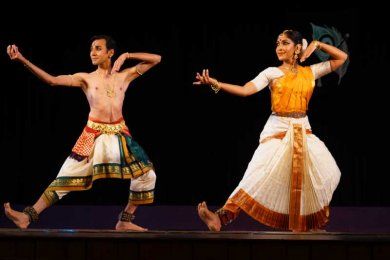Bharatnatyam - My Love
May 31, 2019 • 57 views
India is a land of a art, architecture and literature. We must be proud in saying that we are indians.India has different kinds of dances too.Some of the dances are Kathak, Kathakali, Kuchipudi, Manipuri, Mohiniattam, Odissi and Bharatnatyam.
Bharatnatyam has a special place in everyone’s heart around the globe. Other dances are also equally praised by everyone. But this is known for its complex steps and postures.
The word 'Bharatnatyam' is a combination of four words, arebhava, raga, thaala and natyam. Bharatnatyam is a dance form with compositions of bhavanas (face expression), ragas (music), talas (beats) and natyams (steps that coincide with beats). This dance is originally from Tamil Nadu. This a very old, ancient and antique dance form in India. It was actually confined only to Hindus with spiritual values in it.
History of Bharatnatyam
The mention of this art is seen in a book of second century called “Silappathikaram” and also in a sixth century book called “manimegalai” . The Temples in Tamil Nadu built during ancient days ,have the sculptures and carvings of lord Shiva in bharatnatya poses stating that Bharatnatyam had gained its popularity and power in the midst of first millennium. For example, the southern gateway of Chidambaram temple, which belongs to 12th century, contains lord Shiva being in 108 dance poses of bharatnatyam. This is called as “karnas” in Natya shastra. It is said that "Nataraja" is the god of classical dance and is considered to be another form of lord shiva.

The theory part of bharatnatyam is found in a book called “Natya Shastra” , the ancient Hindu text of performing arts. The book of Natya Shastra consists of about 6000 verses structured into 36 chapters.
Banned and revived
Bharatnatyam was confined within Hindu temples till 19th century. But when the colonial British government banned this dance form in 1910,people arose against this and allowed this dance form to move out of the temple in 20th century.
Siginifance
This dance is significant for its gesture of fixed upper torso, leg bent (araimandi), combined with footwork, and a vocabulary of sign language based on the hand(mudras), eyes and face muscles. It was exclusively only for women during those days.
Repertoires
The repertoires of this performance art are categorized into three categories namely ‘Nritta’, ‘Nritya’ and ‘Natya’ mentioned in ‘Natya Shastra’.
Nritta:This emphasis is only on dance movements.
Nritya:combination of Rhythm and expression. The dancer has to convey by hand (mudras) and face (bhavana) gesture.
Natya: steps done to convey the theme of the song.
We have something called “Arangetram” which is the ultimate dream of every dancer. This is done to show that the dancer has completed the formal training and can pass this art to other learners.
My small experience
I always take pride in saying that I am a Bharatnatyam dancer. I have been in this field for the past 14 years with a break of 4 years in between. Being a dancer, I have seen people respecting my talent. Dance has been a great stressbuster for me when I feel sad or angry. It helps me to keep myself fit and active.
Dancers are considered as"devas who are cursed to be born as humans". Many crave to learn this art and perform. I was lucky enough to get a chance to dance in many temples.
Costume

The costume of Bharatnatyam is a beautiful dress, which steals the eyes of the people watching it. This dress is almost like saree with pleets in it. The lower suit has the pleats like the Japanese fan. It looks beautiful when the dancer poses with the knee bent(araimandi).The dancer's head is decorated with flowers like chandrapirai (looks like a crescent moon) and suriyapirai (which looks like the sun) on both the sides of the head.The eyes of the dancers are highlighted to show the expression.

Nowadays, people know the value of Bharatnatyam and try to learn it. It’s not only confined to a particular religion,or a country or a gender. It has spread all over the world and gained everyone’s respect and love.
